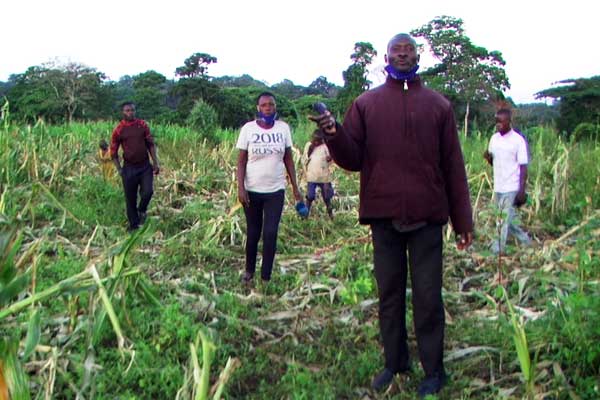Prime
UWA deploys armed rangers to counter wildlife raids in the west

Deputy Speaker, Thomas Tayebwa addressing residents affected by elephant raids in Mitooma District along the border of Queen Elizabeth National Park on Easter Monday. PHOTO | ZADOCK AMANYISA
What you need to know:
- The most hit sub counties include Kiyanga, Rwoburundo and Kigyende. Conflicts of this nature have also been happening in the neighbouring districts of Rubirizi and Kasese.
In Rwoburunga Sub-county in Mitooma District, angry residents neighbouring Queen Elizabeth National Park, took leaders through the gardens and showed them trampled crops. The gardens were destroyed by elephants.
Ignitious Ndyamuhaki, the Ruzonga village chairperson in Rwoburunga Sub-county explains that the human-elephant conflict is pushing the local people into poverty
“People here think that the government does not care about them. No compensation efforts are in place and on top of that, they are fraudulently charged by the police around before registering their damage,” says Benon Karyeija, the Mitooma District chairperson.
On Easter Monday, an emergency meeting was convened and it was attended by Thomas Tayebwa, the deputy Speaker of Parliament Martin Bahinduka Mugarra, the State Minister for Tourism, Wildlife and Antiquities, officials from the Uganda Wildlife Authority (UWA) and communities neighbouring the park. The meeting sought to resolve tensions between communities and park authorities over wildlife raids.
Magnitude of the problem
Elephants have for many years been destroying gardens and human lives. Residents who use to depend on farming have since turned to other sources of livelihood such as charcoal burning, which also threatens the environment.
According to residents, elephants come as early as 5pm and feed on people’s crops till morning. Children who are supposed to be in school now spend hours guarding crops against elephants. This also puts these children in harm’s way.
Mr Richard Mafara, the Kiyanga sub county chairperson stresses, UWA authorities have made it hard for the locals to cross to the park to fetch firewood and herbal medicine.
The most hit sub counties include Kiyanga, Rwoburundo and Kigyende. Conflicts of this nature have also been happening in the neighbouring districts of Rubirizi and Kasese.
Communities neighbouring Queen Elizabeth National park have families whose heads lost lives in the park. Family heads either died guarding their crops against elephant raids or died poaching for economic gains.
“Most of us are widows because our husbands were shot dead by rangers after being found hunting in the park. Elephants disturbed us and we felt like killing them in order to compensate ourselves with ivory. But we were aware that this was illegal,” Birungi Mwanje shares.
In Kasese District, communities have lost domestic animals and crops to lions, leopards and elephants.
In the Kasese-Kikorongo-Kasenyi stretch, the conflict is between animals and humans and on the other hand communities against each other.
“Cultivators accuse pastoralists of failing park fencing efforts because they do not believe there is a park boundary and the land is all theirs for grazing. Cultivators hope a fence can keep wild animals away, but pastoralists do not want the fence,” Mr Walyuba Kule Sylvester, a team leader at Kiwa Heritage, a local tourism firm.
Why the standoff keeps raging
In all mentioned areas, the communities accuse the government of not protecting them against animals, while the government accuses communities of encroaching on the protected areas and failing to observe the boundaries.
As the population keeps growing, people continue to encroach on animal habitats like never before. Scientists estimate that humans are driving wildlife species into extinction at around 1000 times the natural rate due to habitat loss and climate change.
Human-wildlife conflict has turned out to be huge threat to the survival of wildlife in Uganda. In one dimension, animals attack, harm and or kill people, another is where wildlife competes with livestock for grazing space, water, salt licks, and another where humans poach for subsistence, small scale commercial purpose or carryout retaliatory killing according to Justus Tusubira, a conservationist at Space for Giants.
Tusubira notes that over 90 percent of the people living at the fringes of protected areas practice food and cash crop cultivation. The rest are in formal employment and livestock businesses. According to space for giants, crop cultivation takes 90.6 percent, formal employment 2.5 percent, livestock takes 4.4 percent, and business takes 1.9 percent.
“Crop damage is the most important threat to communities because that’s where communities get their livelihood, income and everything,” he says.
David Agaba Kajura, a community conservation ranger in Mitooma district says the interventions put in place do not offer permanent solutions to the fight.
According to the Uganda Wildlife Authority, 70-80 percent of the cases reported are elephants damaging crops.
Way foward
UWA has announced that armed rangers will soon be deployed as a measure to reduce wildlife raids. According to the head of operations at UWA, Charles Tumwesigye, 180 rangers from the batch that has been training at Kaweweta will be deploye by the end of April.
“The park is very big with many problems in each corner. Once the rangers are passed out, they will be assigned work in the park,” he says.
Tumwesigye adds that UWA has contacted the Uganda People’s Defence Forces(UPDF) for the additional workforce of about 12 soldiers whose deployment in the Kiyanga post is being finalised by relevant offices.
Aside from enforcement by rangers, UWA has pledged to install more than 200 bee hives as a short term intervention to facilitate co-existence.
“Bees sting elephants in the snout, the ears, around the eyes and other areas. They target the soft areas of the elephant’s body. Bees do not kill the elephants, they only scare them away and they retreat back into the protected area,” George Owoyesigire, the acting commissioner wildlife conservation in the Ministry of Tourism. He says the intervention has registered success in areas around Kibaale National Park, where they have more than 1500 beehives.
Bees also come with economic opportunities and incentives. “Communities harvest honey for sale and this will increase their incomes. Bees are also one of the most environmental friendly interventions,” he adds.
Deterrent electric fence
In 2019, President Museveni commissioned a 10-kilometre deterrent electric fence covering the periphery of the section of Queen Elizabeth National Park in Rubirizi District, Western Uganda.
The move was keep away wildlife animals from raiding farmers’ crops. In the park, electric fencing covers areas of Kyenzaza-Kagarama(19.5km), Kasese cobalt company Limited-Kikorongo-Kabirizi(32.5km), Kayanja-Isango(6.2km), according to Space for Giants.





